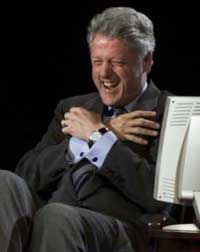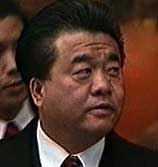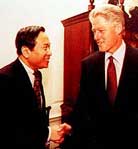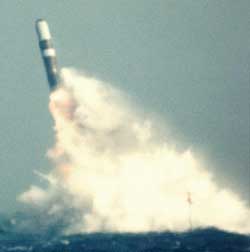|
 Newly
declassified documents show that President Bill Clinton
personally approved the transfer to China of advanced
space technology that can be used for nuclear combat. Newly
declassified documents show that President Bill Clinton
personally approved the transfer to China of advanced
space technology that can be used for nuclear combat.
The documents show that in 1996 Clinton approved the
export of radiation hardened chip sets to China. The
specialized chips are necessary for fighting a nuclear
war.
"Waivers may be granted upon a national interest
determination," states a Commerce Department document
titled "U.S. Sanctions on China."
"The President has approved a series of satellite
related waivers in recent months, most recently in
November, 1996 for export of radiation hardened chip
sets for a Chinese meteorological satellite," noted the
Commerce Department documents.
These special computer chips are designed to function
while being bombarded by intense radiation. Radiation
hardened chips are considered critical for atomic
warfare and are required by advanced nuclear tipped
missiles.
Judicial Watch obtained the documents through the
Freedom of Information Act, a Washington-based political
watchdog group.
Several documents were withheld from release by the U.S.
Commerce Department for commercial and personal privacy
exemptions, but none of the documents were withheld for
national security reasons. Judicial Watch is expected to
appeal the withholdings.
Decade of Betrayal
U.S. intelligence sources stated that the newly released
documents illustrate the extent to which the Clinton
White House placed trade – and trade with China
specifically – above national security.
"In all likelihood we will be glowing in the dark before
we discover the true extent of the Clinton decade of
betrayal," stated Rick Fisher, Asian Security Fellow at
the Center for Security Policy.
 "If
it was indeed intended for a new PRC weather satellite,
then it is possible that it was used for their new polar
orbit weather satellites. This is significant because
the Chinese themselves acknowledge that their polar
orbit weather satellites directly contribute to their
long-range missile targeting capability. This becomes
even more important for their new smaller but more
accurate warheads, used on their new DF-31, DF-31A, DF-5
Mod2 and JL-2 missiles. If they encounter significant
weather, warhead accuracy degrades, reducing their
utility," stated Fisher. "If
it was indeed intended for a new PRC weather satellite,
then it is possible that it was used for their new polar
orbit weather satellites. This is significant because
the Chinese themselves acknowledge that their polar
orbit weather satellites directly contribute to their
long-range missile targeting capability. This becomes
even more important for their new smaller but more
accurate warheads, used on their new DF-31, DF-31A, DF-5
Mod2 and JL-2 missiles. If they encounter significant
weather, warhead accuracy degrades, reducing their
utility," stated Fisher.
 "Inasmuch
as similar U.S. military weather satellites perform the
same missions, the Clinton Administration had to have
known they were assisting a PLA strategic military
capability," concluded Fisher. "Inasmuch
as similar U.S. military weather satellites perform the
same missions, the Clinton Administration had to have
known they were assisting a PLA strategic military
capability," concluded Fisher.
In addition, the Chinese military is clearly interested
in acquiring advanced radiation hardened computer chips
for its strategic nuclear arsenal.
U.S. Chips for PRC Nukes
Currently, China has only liquid fueled, long-range
missiles, and the majority of them are based inside
underground silos. These long-range rockets are reported
to be "bore-sighted" – meaning the underground silos are
aimed directly at target cities inside the United
States.
The Chinese army is now attempting to shift its
strategic nuclear arsenal to a solid-fuel "launch on
command" capability. These new missiles are rail- and
road-mobile and require sophisticated electronic
guidance systems to accurately strike their intended
targets.
As part of this upgrade, the Chinese army is also
modifying its nuclear warhead designs to arm new
survivable missiles such as the DF-31 and JL-2. Chinese
engineers are planning to equip these new missiles with
MIRV technology, allowing each missile to carry multiple
nuclear warheads.
Again, the U.S. radiation hardened computer chip
technology is a logical addition to the reconfiguration
and upgrade of Chinese nuclear weapons.
Stolen U.S. Chips
Another critical element of the Clinton-supplied waiver
is the fact that it took place during an investigation
of Chinese espionage into missing U.S. radiation
hardened satellite chips.
In February 1996, a Chinese Long March rocket carrying a
Loral Intelsat satellite failed and crashed on lift-off.
The Loral Intelsat payload was badly damaged. The
Chinese intended to launch the Loral satellite into deep
space as they had been paid to do by Loral CEO Bernard
Schwartz.
However, fate took a twisted path, and so did the
Chinese rocket. The Long March rocket failed on launch
and crashed into a nearby Chinese village, killing over
200 innocent civilians. The failure of the Long March
allowed the U.S. to recover the sealed satellite
guidance box, which revealed the control board of
radiation-hardened chips was missing.
The missing board from the Loral Intelsat satellite is
no mystery. It quickly became obvious that Chinese
engineers removed the special electronics and kept the
board for examination. The stolen Loral electronics
consist of radiation hardened, encrypted telemetry
chips, stored in a secure flight control box similar to
those found on airliners. The NSA changed all U.S.
satellite codes as a result of the stolen Loral chips,
costing American taxpayers millions of dollars.
1996 Illegal Campaign Donations
 |
| Johnny Chung |
 |
| John Huang |
 |
| Charlie Trie |
Another factor involved
in the November 1996 waiver issued by then-President
Clinton is the fact that illegal money entered the U.S.
elections from the Chinese army. The money was donated
to the DNC from a variety of sources including convicted
Chinagate figures John Huang, Charlie "Yah-Lin" Trie and
Johnny Chung.
The 1996 Clinton-Gore campaign readily accepted much of
the money from the Chinese army sources without
question, and in some cases took these donations in
cash. The allegations of Chinese espionage and illegal
campaign donations were never investigated properly.
The successful effort by China to obtain U.S. microchip
technology included espionage, sabotage and perhaps
bribery. The red intelligence windfall freed the Chinese
army to more accurately target American cities with
atomic weapons using advanced U.S technology.
The legacy that President Clinton left for the 21st
century is a modern Chinese army equipped for global
nuclear war.
PRC Stole U.S. Nuclear Warhead Designs
The People's Republic of China (PRC) has stolen
classified information on all of the United States' most
advanced thermonuclear warheads, and several of the
associated reentry vehicles. These thefts are the result
of an intelligence collection program spanning two
decades, and continuing to the present. The PRC
intelligence collection program included espionage,
review of unclassified publications, and extensive
interactions with scientists from the Department of
Energy's national weapons laboratories.
The stolen U.S. secrets have helped the PRC fabricate
and successfully test modern strategic thermonuclear
weapons. The stolen information includes classified
information on seven U.S. thermonuclear warheads,
including every currently deployed thermonuclear warhead
in the U.S. intercontinental ballistic missile arsenal.
Together, these include the W-88 Trident D-5
thermonuclear warhead, and the W-56 Minuteman II, the
W-62 Minuteman III, the W-70 Lance, the W-76 Trident
C-4, the W-78 Minuteman III Mark 12A, and the W-87
Peacekeeper thermonuclear warheads. The stolen
information also includes classified design information
for an enhanced radiation weapon (commonly known as the
"neutron bomb"), which neither the United States, nor
any other nation, has ever deployed.
 In
addition, in the mid-1990s the PRC stole from a U.S.
national weapons laboratory classified U.S.
thermonuclear weapons information that cannot be
identified in this unclassified Report. Because this
recent espionage case is currently under investigation
and involves sensitive intelligence sources and methods,
the Clinton administration has determined that further
information cannot be made public. In
addition, in the mid-1990s the PRC stole from a U.S.
national weapons laboratory classified U.S.
thermonuclear weapons information that cannot be
identified in this unclassified Report. Because this
recent espionage case is currently under investigation
and involves sensitive intelligence sources and methods,
the Clinton administration has determined that further
information cannot be made public.
The W-88 is a miniaturized, tapered thermonuclear
warhead. It is the United States' most sophisticated
strategic thermonuclear weapon. In the U.S. arsenal, the
W-88 warhead is mated to the D-5 submarine-launched
ballistic missile carried aboard the Trident nuclear
submarine. The United States learned about the theft of
the W-88 Trident D-5 warhead information, as well as
about the theft of information regarding several other
thermonuclear weapons, in 1995.
On two occasions, the PRC has stolen classified U.S.
information about neutron warheads from a U.S. national
weapons laboratory. The United States learned of these
thefts of classified information on the neutron bomb in
1996 and in the late 1970s, when the first theft --
including design information on the W-70 warhead --
occurred. The W-70 warhead contains elements that may be
used either as a strategic thermonuclear weapon, or as
an enhanced radiation weapon ("neutron bomb"). The PRC
subsequently tested the neutron bomb. The U.S. has never
deployed a neutron weapon.
In addition, the Select Committee is aware of other
PRC thefts of U.S. thermonuclear weapons-related
secrets. The Clinton administration has determined that
further information about these thefts cannot be
publicly disclosed.
The Select Committee judges that the PRC will exploit
elements of the stolen U.S. design information for the
development of the PRC's new generation strategic
thermonuclear warheads. Current PRC silo-based missiles
were designed for large, multi-megaton thermonuclear
warheads roughly equivalent to U.S. warheads of the late
1950s. The PRC plans to supplement these silo-based
missiles with smaller, modern mobile missiles that
require smaller warheads. The PRC has three mobile ICBM
programs currently underway ñ two road-mobile and one
submarine launched program ñ all of which will be able
to strike the United States.
The first of these new People's Liberation Army (PLA)
mobile ICBMs, the DF-31, may be tested in 1999 and could
be deployed as soon as 2002. The DF-31 ICBM and the
PRC's other new generation mobile ICBMs will require
smaller, more compact warheads. The stolen U.S.
information on the W-70 or W-88 Trident D-5 will be
useful for this purpose.
The PRC has the infrastructure and technical ability
to use elements of the stolen U.S. warhead design
information in the PLA's next generation of
thermonuclear weapons. If the PRC attempted to deploy an
exact replica of the U.S. W-88 Trident D-5 warhead, it
would face considerable technical challenges. However,
the PRC could build modern thermonuclear warheads based
on stolen U.S. design information, including the stolen
W-88 design information, using processes similar to
those developed or available in a modern aerospace or
precision guided munitions industry. The Select
Committee judges that the PRC has such infrastructure
and is capable of producing small thermonuclear warheads
based on the stolen U.S. design information, including
the stolen W-88 information.
The Select Committee judges that the PRC is likely to
continue its work on advanced thermonuclear weapons
based on the stolen U.S. design information. The PRC
could begin serial production of advanced thermonuclear
weapons based on stolen U.S. design information during
the next decade in connection with the development of
its new generation of intercontinental ballistic
missiles.
The Select Committee judges that the PRC's
acquisition of U.S. classified information regarding
thermonuclear warhead designs from the Department of
Energy's national weapons laboratories saved the PRC
years of effort and resources, and helped the PRC in its
efforts to fabricate and successfully test a new
generation of thermonuclear warheads. The PRC's access
to, and use of, classified U.S. information does not
immediately alter the strategic balance between the U.S.
and PRC. Once the PRC's small, mobile strategic
ballistic missiles are deployed, however, they will be
far more difficult to locate than the PRC's current
silo-based missiles. This will make the PRC's strategic
nuclear force more survivable. Small, modern nuclear
warheads also enable the PRC to deploy multiple reentry
vehicles (MRVs or MIRVs, multiple independently-targetable
reentry vehicles) on its ICBMs should it choose to do
so.
The PRC's collection of intelligence on smaller U.S.
thermonuclear warheads began in the 1970s, when the PRC
recognized its weaknesses in physics and the
deteriorating status of its nuclear weapons programs.
The Select Committee judges that the PRC's intelligence
collection efforts to develop modern thermonuclear
warheads are focused primarily on the U.S. Department of
Energy's National Laboratories at:
- Los Alamos
- Lawrence Livermore
- Oak Ridge
- Sandia
The FBI has investigated a number of U.S. National
Laboratory employees in connection with suspected
espionage.
The Select Committee judges that the U.S. national
weapons laboratories have been and are targeted by PRC
espionage, and almost certainly remain penetrated by the
PRC today.
The United States did not become fully aware of the
magnitude of the counterintelligence problem at
Department of Energy national weapons laboratories until
1995. A series of PRC nuclear weapons test explosions
from 1992 to 1996 began a debate in the U.S. Government
about whether the PRC's designs for its new generation
of nuclear warheads were in fact based on stolen U.S.
classified information. The apparent purpose of these
PRC tests was to develop smaller, lighter thermonuclear
warheads, with an increased yield-to-weight ratio. In
1995, a "walk-in" approached the Central Intelligence
Agency outside the PRC and provided an official PRC
document classified "Secret" that contained specific
design information on the W-88 Trident D-5, and
technical information on other thermonuclear warheads.
The CIA later determined that the "walk-in" was directed
by the PRC intelligence services. Nonetheless, CIA and
other Intelligence Community analysts that reviewed the
document concluded that it contained U.S. warhead design
information.
The National Security Advisor was briefed on PRC
thefts of classified U.S. thermonuclear warhead design
information in April 1996 (when he was the Deputy
National Security Advisor), and again in August 1997. In
response to specific interrogatories from the Select
Committee, the National Security Advisor informed the
Select Committee that the President was not briefed
about the issue and the long-term counterintelligence
problems at the Department of Energy until early 1998.
The Secretary of Energy was briefed about the matter in
late 1995 and early 1996. At the writing of this report,
the Secretary of Defense has been briefed, but not the
Secretaries of State and Commerce.
Congress was not provided adequate briefings on the
extent of the PRC's espionage program.
Under Presidential Decision Directive 61 issued in
February 1998, the Department of Energy was required to
implement improved counterintelligence measures. In
December 1998, the Department of Energy began to
implement a series of recommended improvements to its
counterintelligence program approved by Secretary
Richardson in November 1998. Based on testimony by the
new head of the Department of Energy's
counterintelligence program, the unsuccessful history of
previous counterintelligence programs at the Department
of Energy, and other information that is not publicly
available, the Select Committee judges that the new
counterintelligence program at the Department of Energy
will not be even minimally effective until at least the
year 2000.
Since the collapse of the Soviet Union, and
continuing today, Russia is cooperating with the PRC in
numerous military and civilian programs, including the
PRC's civilian nuclear program. The Select Committee is
concerned about the possibility of cooperation between
Russia and the PRC on nuclear weapons. The Select
Committee judges that Russian nuclear weapons testing
technology and experience could significantly assist the
PRC's nuclear weapons program, including the PRC's
exploitation of stolen U.S. thermonuclear warhead design
information. This is especially true if the PRC complies
with the Comprehensive Test Ban Treaty, which does not
permit the physical testing of nuclear weapons.
|